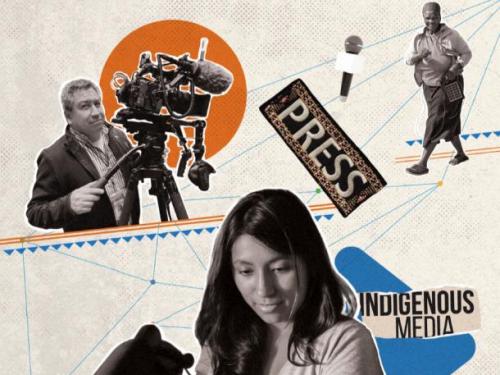
The study Indigenous Peoples and the Media is a result of two years of extensive research and consultations with a wide range of stakeholders. It responds to a 2023 UNPFII recommendation for UNESCO to examine the national policies, practices and funding programmes related to Indigenous Peoples and the media. This work contributes to the implementation of Article 16 of the UN Declaration on the Rights of Indigenous Peoples (UNDRIP), which affirms the right of Indigenous Peoples to create their own media in their languages, access non-Indigenous media without discrimination, and calls on states to ensure both public and private media reflect Indigenous cultural diversity.
As the comprehensive mapping of media for and by Indigenous Peoples to date, the study collected responses from 308 Indigenous media organizations across 74 countries and 128 non-Indigenous media outlets in 41 countries through a global survey. It also incorporates a literature review that analyzed 303 academic papers, 51 policy documents and 35 media guidelines, which underscore significant limitations in global research, resulting in lack of critical evidence for policymakers to take informed decisions.
Another pillar of this study is an English-language media monitoring from 2023 onwards, revealing more than 1.4 million articles on Indigenous issues, with a cumulative audience reach estimated at 3.3 billion. Data reveals that while coverage is increasing and sentiment is slowly shifting, challenges remain around stereotyping, underrepresentation and a lack of Indigenous voices in non-Indigenous narratives.
Alongside the data collection, the study draws on extensive input gathered through multi-stakeholder consultations. These discussions brought together Indigenous media practitioners, UN entities, academics, and civil society actors to validate findings, share insights and co-develop recommendations grounded in good practices.
Among the key findings from the global survey:
Indigenous Peoples’ content is essential to advancing media development. By bringing in their voices, their cultural expression, languages and knowledge into the media landscape, indigenous voices strengthen media pluralism and diversity, and help media more accurately reflect society. A thriving media landscape depends on the representation and amplification of Indigenous narratives, ensuring exchange of ideas across audiences:
-
Most Indigenous media are community-driven: 61% were founded by Indigenous Peoples.
-
Radio remains the dominant platform among Indigenous media (34%), followed by digital-only (23%) and hybrid formats (17%).
-
Majority operates with minimal human resources: 70% of Indigenous media outlets employ fewer than 10 paid staff; nearly one in four have no paid staff at all and work on voluntary basis.
-
73% of Indigenous media cite a lack of financial resources, limiting their reach and digital expansion. 51% face challenges that are related to high equipment costs.
-
20% of Indigenous media report to the tribal or community councils. This could raise considerations regarding their editorial independence, accountability and self-monitoring.
Despite the potential value of using Indigenous languages in the media to reach both Indigenous audiences and the public interested in Indigenous issues, this potential has not been adequately explored:
-
Use of Indigenous languages is present in Indigenous radio (84%) and digital outlets (82%), while only 47% of non-Indigenous media use Indigenous languages, often only where quotas apply.
-
16% of non-Indigenous media are obliged to publish Indigenous language by quotas.
-
32% of Indigenous media broadcast daily programmes and 24% offer permanent programmes in Indigenous languages.
Differences in representation and editorial practices have been observed across non-Indigenous media outlets.
-
25% of non-Indigenous outlets have no editorial guidelines related to Indigenous issues.
-
One in five rarely cite Indigenous Peoples as sources on public interest issues, and 8% say they never do.
-
Around 50% of media organizations allocate their airtime/space for public information, followed by cultural practices and public health information and emergencies.
The management practices and operations of the media industry regarding Indigenous media professionals have the potential for enhancement:
-
Indigenous women media professionals are part of the media organizations, but gaps remain: While 35% of Indigenous media reported a majority-female staff, 9% employ no women. In non-Indigenous media, 36% said they employ no Indigenous women at all.
-
A worrying 49% of Indigenous media workers reported being exposed to external threats, including online harassment, physical danger, and legal intimidation.
-
60% of non-Indigenous media do not offer specific training to cover Indigenous issues.
-
Only 8% of funding in non-Indigenous media have access to direct public funding to cover Indigenous issues.
To address the identified gaps, UNESCO's study outlines 12 recommendations for governments, media organizations, donors, and international actors. These include strengthening legal recognition of Indigenous media, promoting equitable editorial policies, supporting Indigenous-language media, and ensuring safer, more inclusive working conditions.
Empowering Indigenous voices in the media is crucial for fostering pluralism and diversity, which are essential elements of a vibrant society. Through partnerships between Indigenous and mainstream media, we amplify diverse voices and perspectives, shaping a more inclusive, sustainable and effective media sector.
The study was prepared in collaboration with the members of the working group, namely the former UN Special Rapporteur on the Rights of Indigenous Peoples, José Francisco Cali Tzay, research team from the Griffith University (Australia), media practitioners from the Indigenous Journalists Association (IJA), the European Broadcasting Union (EBU), the Public Media Alliance (PMA), the Deutsche Welle Akademie in Latin America (DW Akademie), the International Information Centre for Terminology (INFOTERM), the Office of the United Nations High Commissioner for Human Rights (OHCHR), and other public organizations, media practitioners, as well as experts who attended the Expert Meeting to prepare a study on Indigenous Peoples and the Media, and Media Partnership Forum, convened at the UNESCO Headquarters in Paris, France, from 26 to 27 November 2024.










